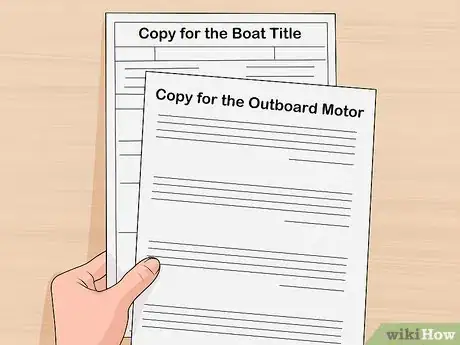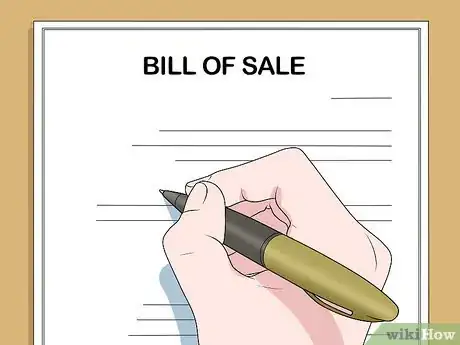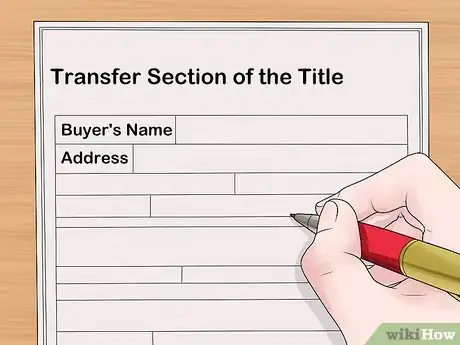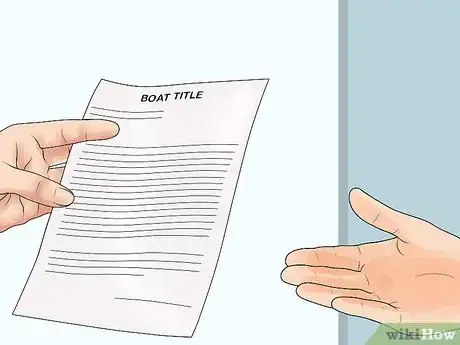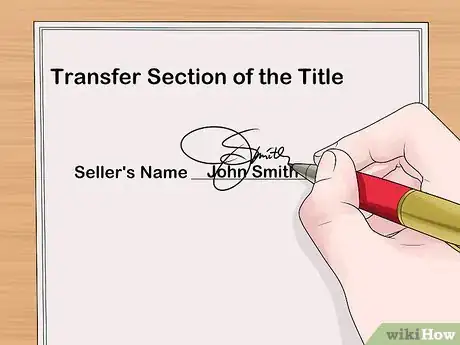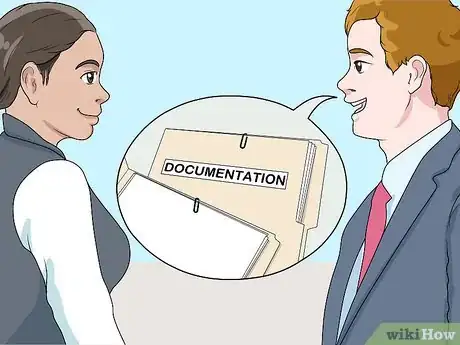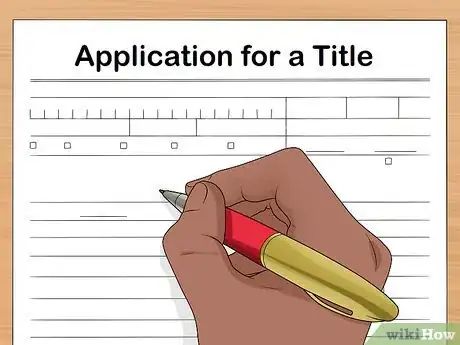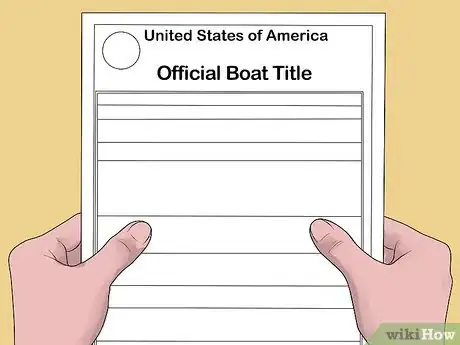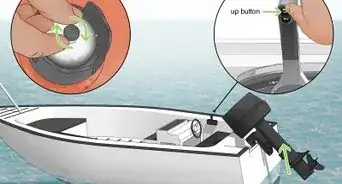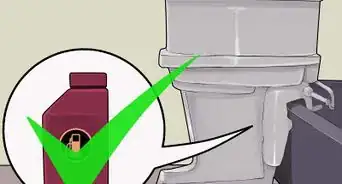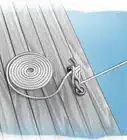This article was written by Jennifer Mueller, JD. Jennifer Mueller is an in-house legal expert at wikiHow. Jennifer reviews, fact-checks, and evaluates wikiHow's legal content to ensure thoroughness and accuracy. She received her JD from Indiana University Maurer School of Law in 2006.
This article has been viewed 92,511 times.
If you want to operate a boat in American waters, it must be titled and registered in the state where you live. Part of the process of buying a boat from another individual is getting the boat title transferred from the seller's name into your name. While the process is fairly straightforward, mistakes could result in disputes over the ownership of the boat.[1]
Steps
Selling a Boat
-
1Gather required proof of ownership. In general, you'll need your copy of the title for the boat and the title for the outboard motor. In some states, these may be two separate title documents.[2]
- If you had the boat financed and there is a lien on the title, you'll also need documentation for release of that lien from the finance company.
-
2Complete a bill of sale. An official bill of sale provides a record of the sale and the amount for which you sold the boat. Some states require the buyer to present a written bill of sale when they apply to transfer the title.[3]
- Even if your state does not require a bill of sale, it's still good practice to have a written document recording the transaction, in case questions or problems arise later.
- Take the bill of sale to a notary public so your signature and the buyer's signature on the bill of sale can be notarized. If the transaction is later disputed, the document will more likely hold up in court. Have 2 copies notarized so both you and the buyer have an original.
Advertisement -
3Fill in the transfer section of the title. On the back of the boat title, there will be a section to record the transfer of the boat to another person. Write the buyer's name, address, and any other information required.
- Check with the buyer to make sure the information you have is correct. Write legibly in blue or black ink.
-
4Sign the title in the presence of a notary. To complete the transfer of the title to the buyer, you must sign the back of the title below the transfer section. Some states require your signature to be notarized.
- If there is a space for a notary seal on the back of the title, that's an indication that the signature must be notarized. If you're unsure, you can call your state's boat licensing office to find out.
- Getting the title notarized at the same time you have the bill of sale notarized can save you some time and money.
-
5Give the title to the buyer. Once you've completed the transfer section on the back of the title and signed it, it's the buyer's responsibility to take it to the title office in your state and apply for a new title.
- You may want to make a photocopy of the title before you hand it over, so you have it for your records. This might come in handy if, for example, the buyer misplaces the title before they get a chance to go to the title office.
-
6Accompany the buyer to the title office. Until the buyer applies for a new title, the boat is still in your name. If you go to the title office with the buyer, you can make sure the buyer gets their new title promptly.[4]
- If there are any questions or problems with your title, you also have the opportunity to clear those problems up immediately if you're there in person.
Purchasing a Boat
-
1Have the seller sign the title. Before you can have the title to your newly purchased boat transferred into your name, the seller must fill out the transfer section on the back of the title and sign it.
- Some states require titles to be signed in the presence of a notary. If there is space for a notary seal on the back of the title, don't let the seller sign it until they're in front of a notary. Otherwise the signature will be invalid.
-
2Request documentation from authorized representatives. Some sellers may have an authorized representative, such as an attorney or dealer, complete the title transfer for them.[5]
- An authorized representative should have a contract, power of attorney, or other document that makes it clear they are the legal, authorized representative of the title owner of the boat.
- If the representative cannot produce documentation, don't go through with the sale – it might not be legitimate. Contact the title owner of the boat if possible.
-
3Have the seller accompany you to the title office. Having the seller with you can help you avoid a nasty surprise if you find out there is some sort of problem with the title or the record of ownership for the boat.[6]
- With the seller by your side, most problems can be cleared up immediately. For example, the title may have a lien on it. The seller could produce a release of lien document to prove that they owned the boat free and clear when they sold it.
-
4Complete an application for a title. Each state has a title application form that you must fill out with your name, address, and other information regarding the boat you've just purchased. The information you provide will be used to issue your new title.[7]
- Some states also require you to present a written bill of sale for the boat. If you're buying the boat from an individual, you may want to call your state's boat titling office in advance and find out what documents you'll need.
- Make sure all information about the boat is exactly the same as the information on the original title. This ensures a clean transfer of title.
-
5Pay any required taxes and fees. When you submit your title application to the title office, you'll typically be assessed taxes and fees on your purchase. These taxes vary widely among states. It's a good idea to call ahead and find out how much you'll have to pay, as well as what methods of payment are accepted.[8]
- Some states don't assess taxes on casual boat sales (sales between two private individuals). However, you'll still have to pay a fee to have the new title issued, typically around $15 or $20.
-
6Receive your new title. In some states, you'll get your title immediately after you submit your application and pay the fees. However, many states will give you a temporary document and send your official title in the mail.
- If you have to wait for your official title, find out if you can still register your boat with the temporary document. You won't be able to take the boat out on the water until it's registered.
References
- ↑ https://tpwd.texas.gov/fishboat/boat/owner/buying_and_selling/
- ↑ https://tpwd.texas.gov/fishboat/boat/owner/buying_and_selling/
- ↑ http://www.dnr.sc.gov/boating/registration.html
- ↑ https://tpwd.texas.gov/fishboat/boat/owner/buying_and_selling/
- ↑ https://tpwd.texas.gov/fishboat/boat/owner/buying_and_selling/
- ↑ https://tpwd.texas.gov/fishboat/boat/owner/buying_and_selling/
- ↑ http://www.dnr.sc.gov/boating/Titling_and_Registration/index.html
- ↑ http://www.dnr.sc.gov/boating/Titling_and_Registration/index.html
About This Article
To transfer a boat title, first locate your proof of ownership for the boat and its outboard motor. Then, complete a bill of sale if this is required by your state. Regardless of whether you need a bill of sale, fill in the transfer section on the back of the boat title with details of the buyer’s name and address. Once you’ve filled in the transfer section, meet with a notary so they can confirm both you and the buyer’s signatures. After you’ve signed it, give the title to the buyer. At this point, you can go with the buyer to the title office to make sure they get their new title. For more tips from our Legal co-author, including how to transfer a boat title to your name, read on!
